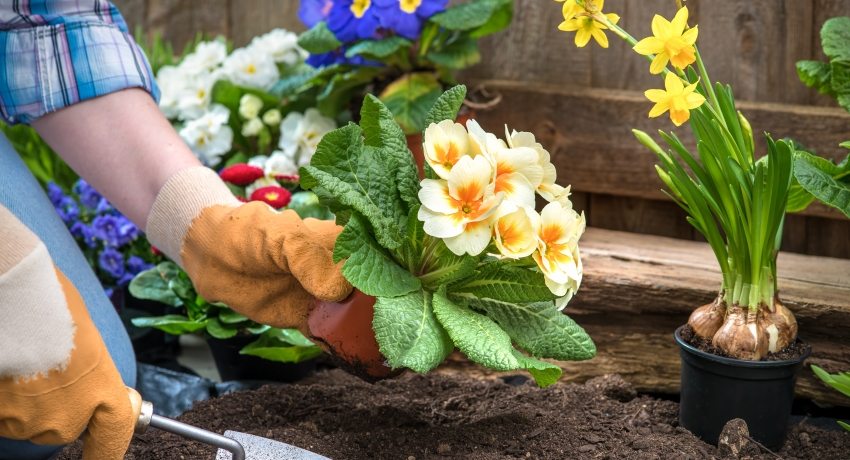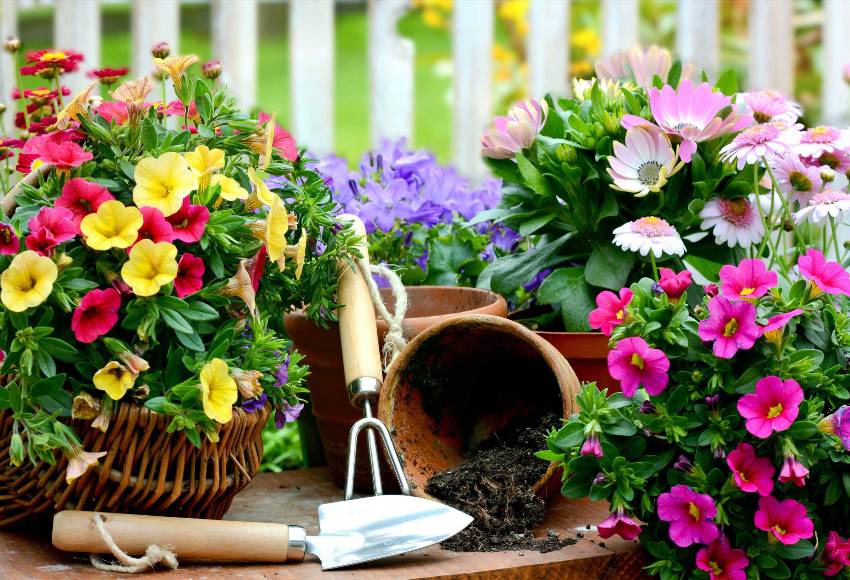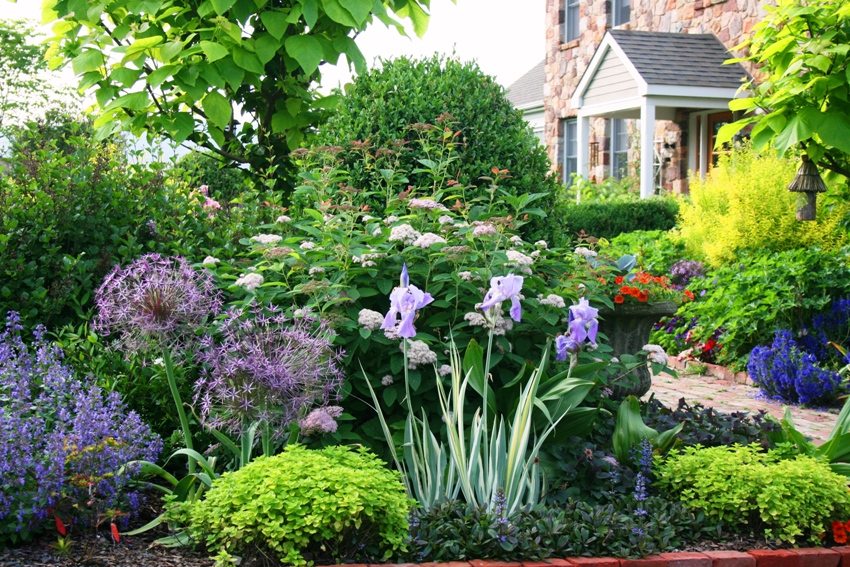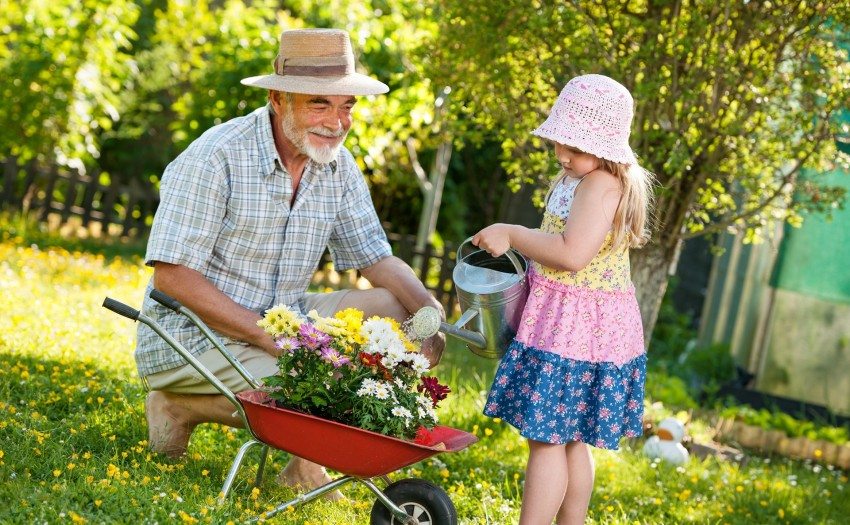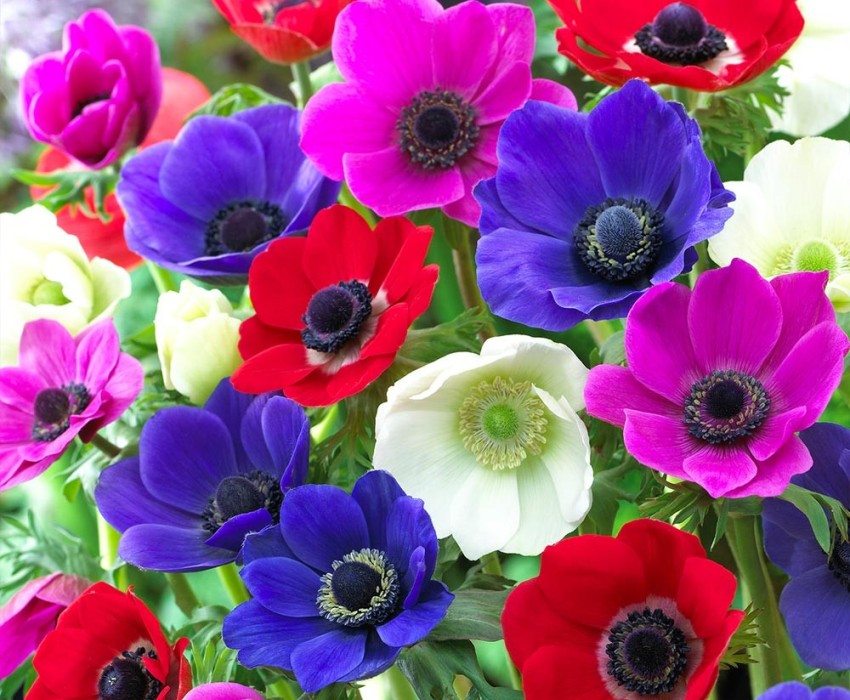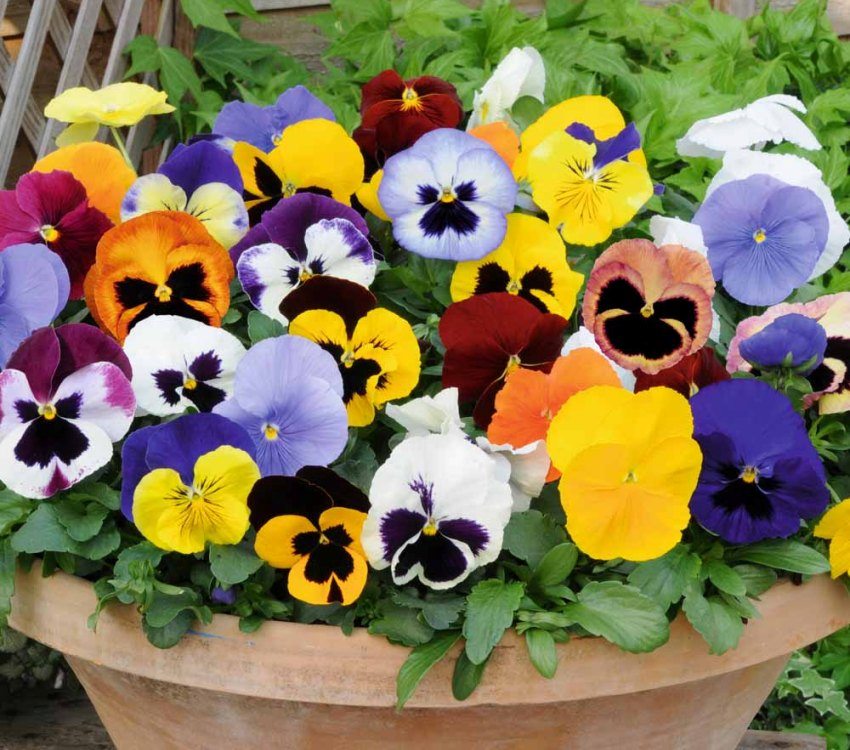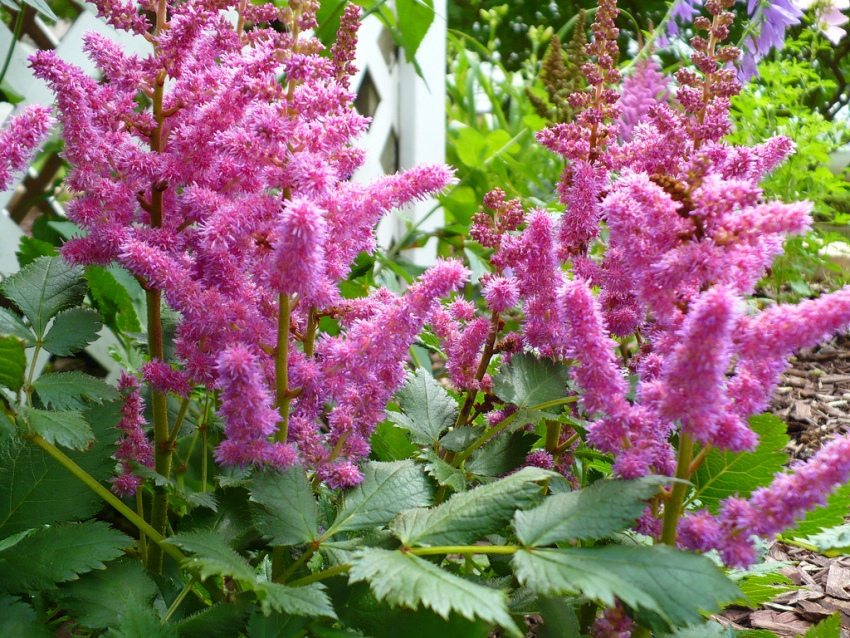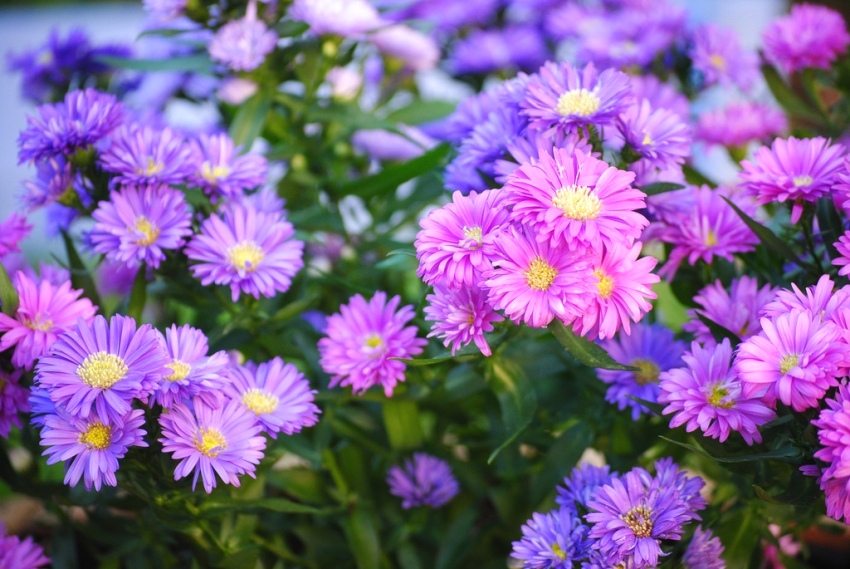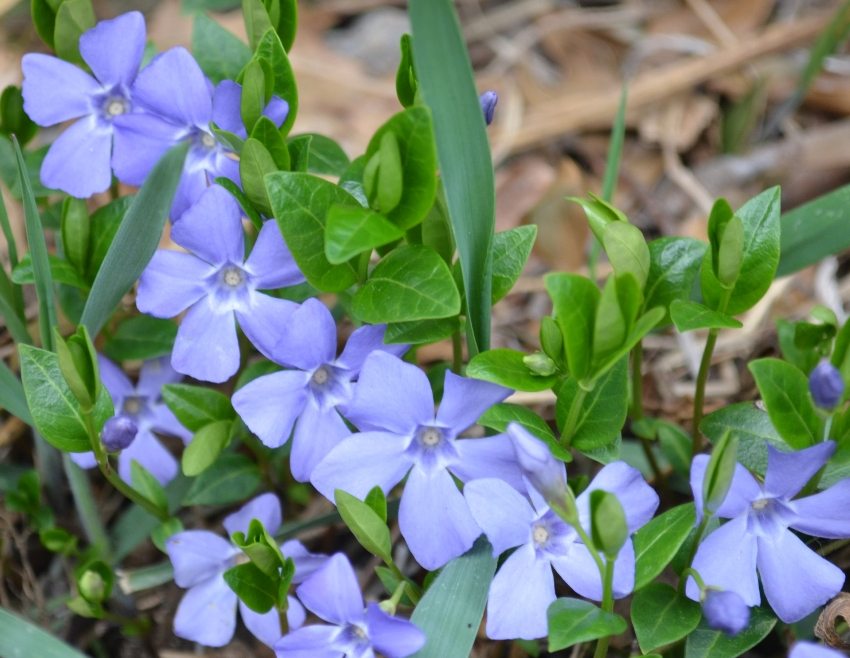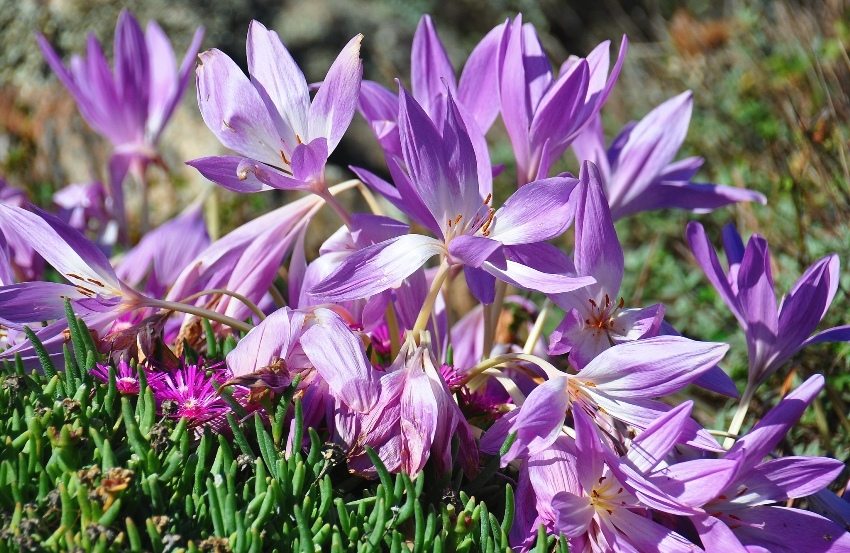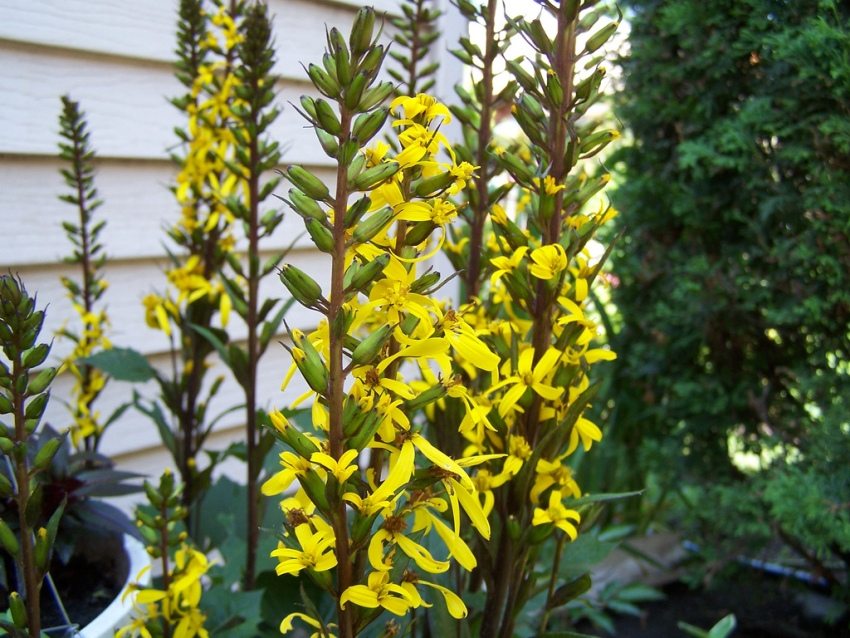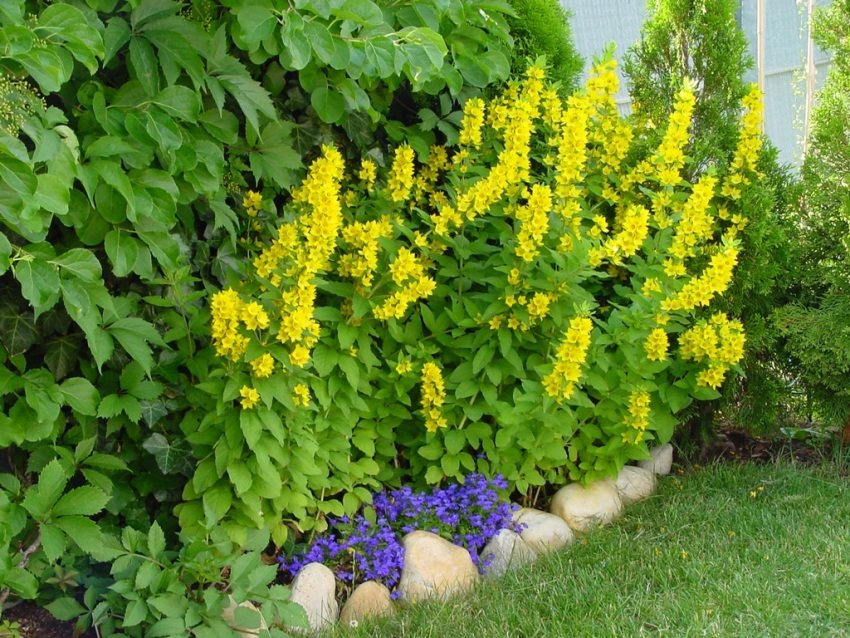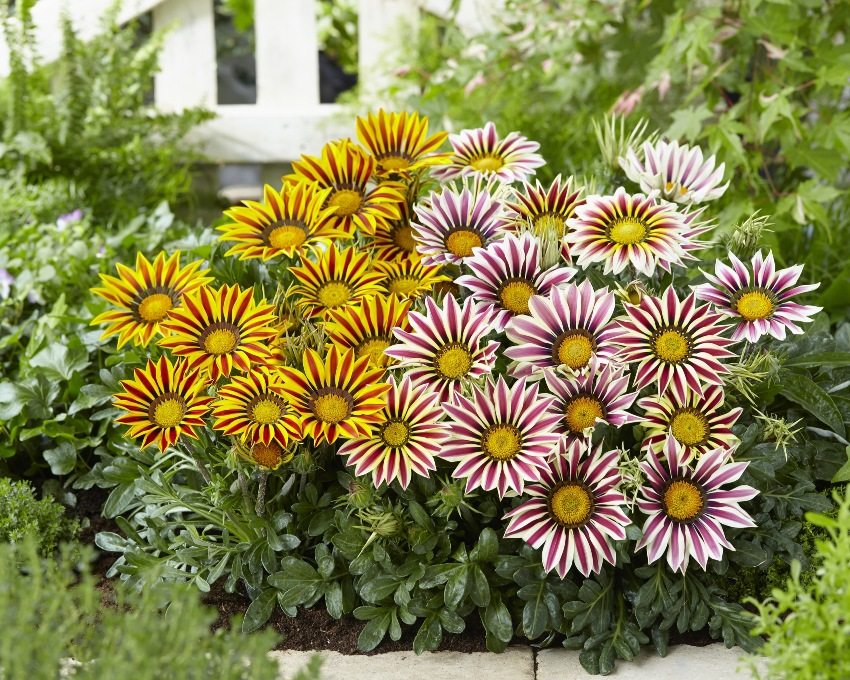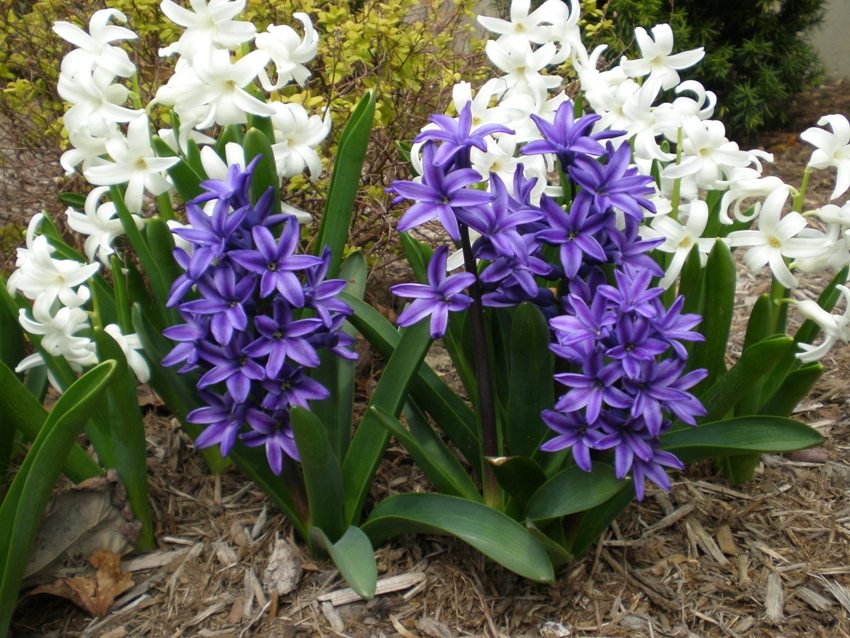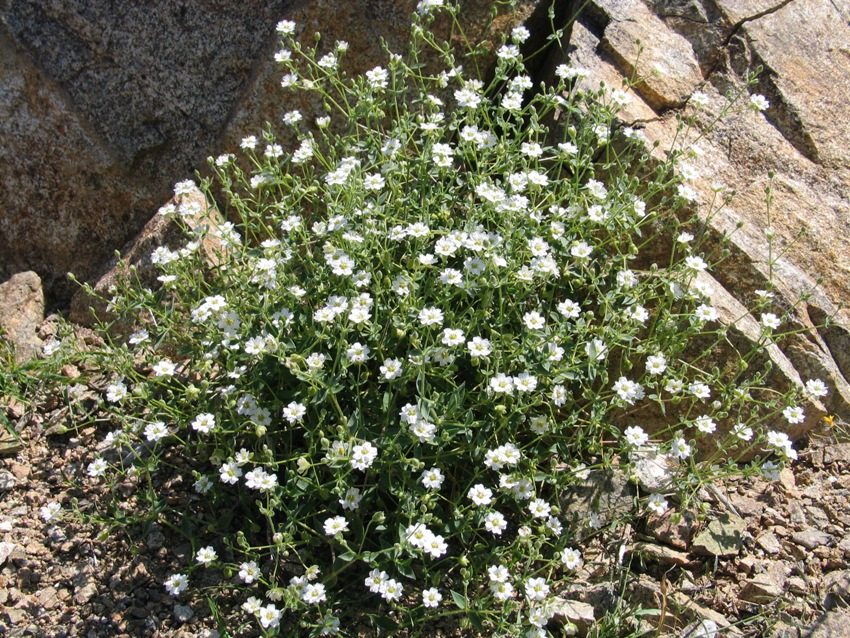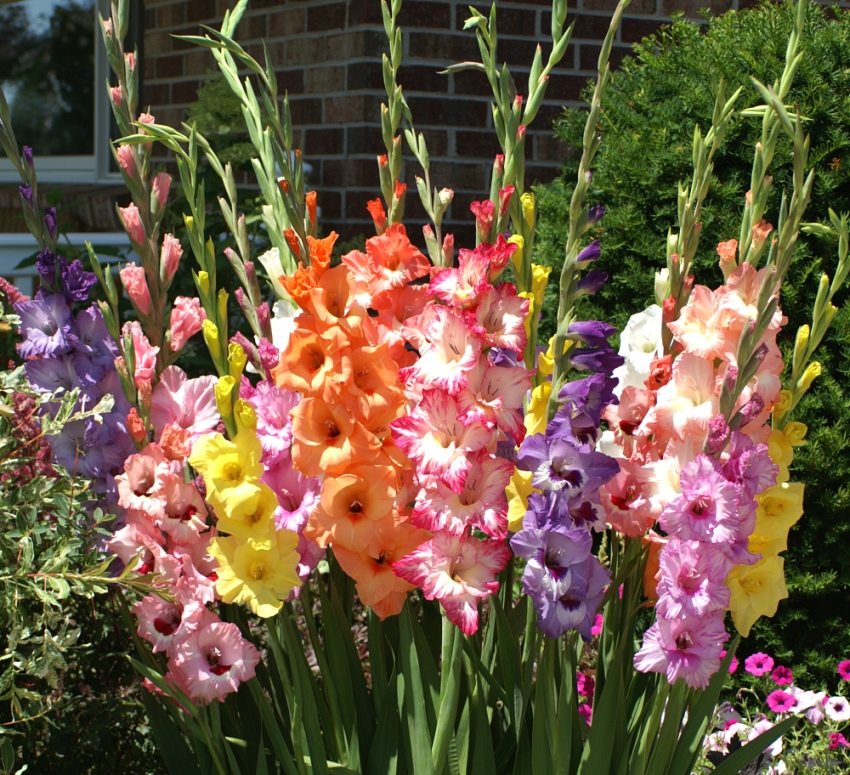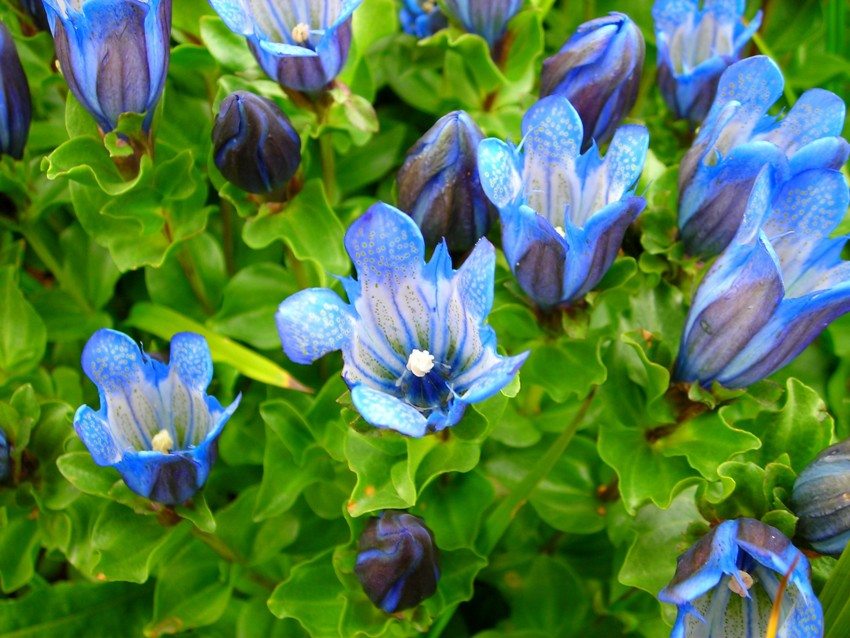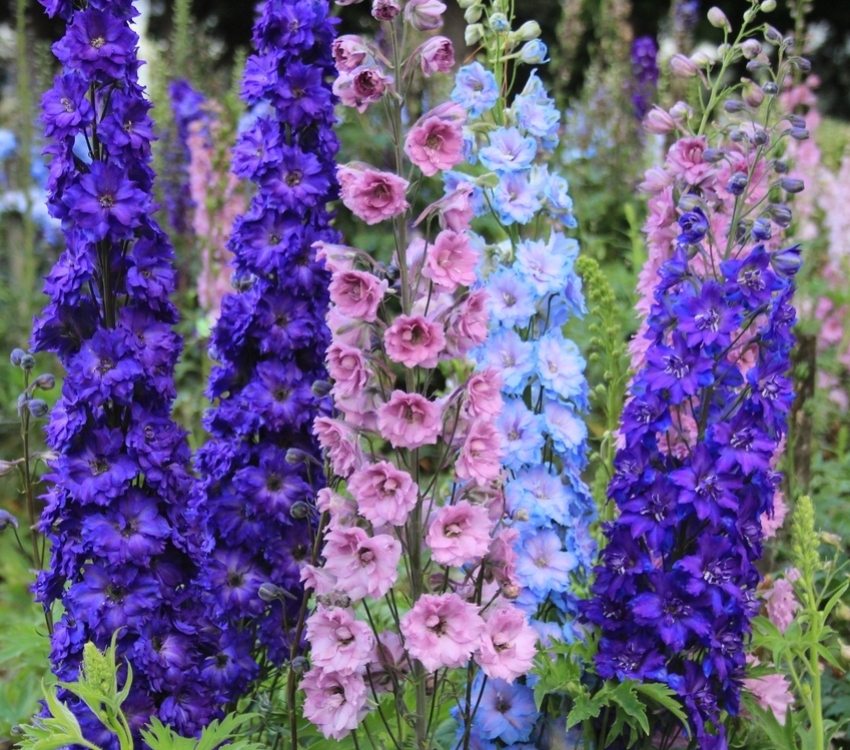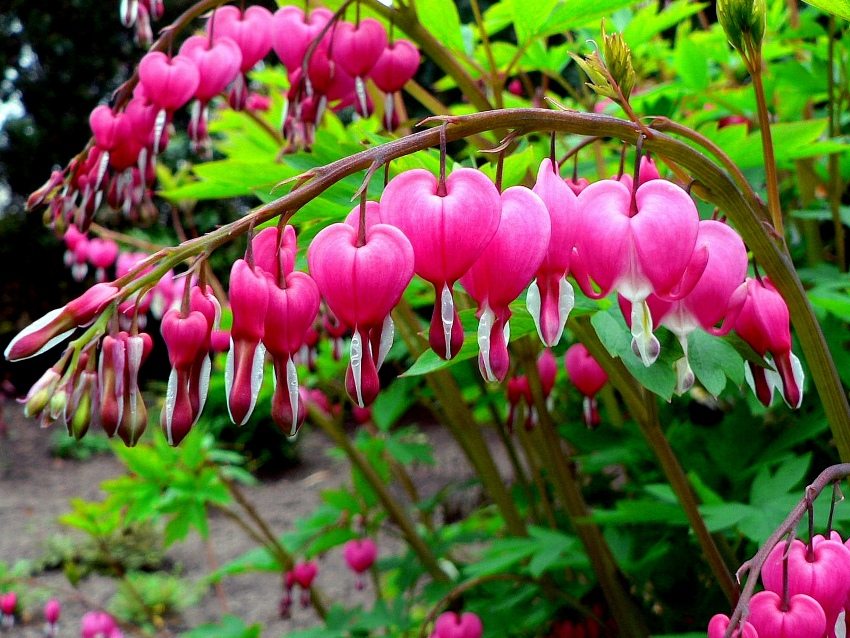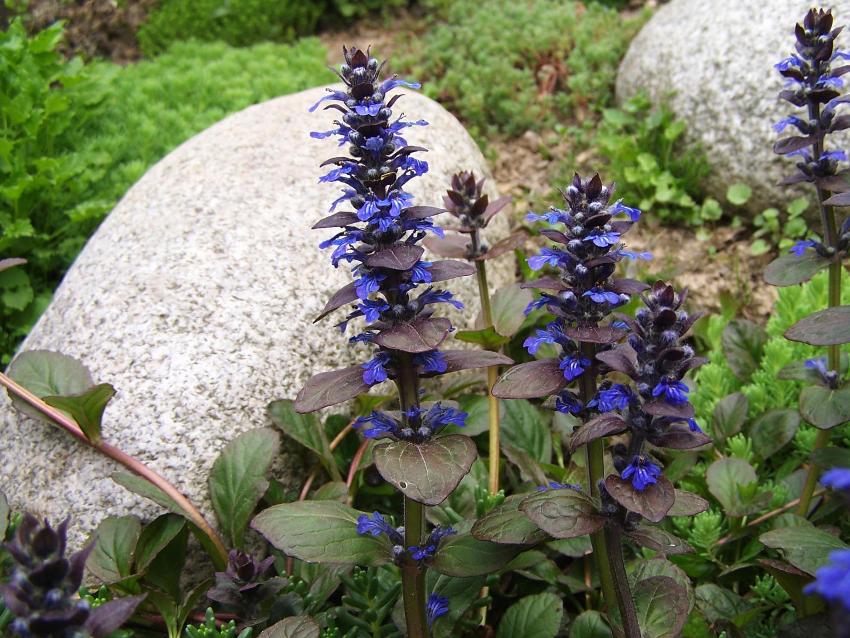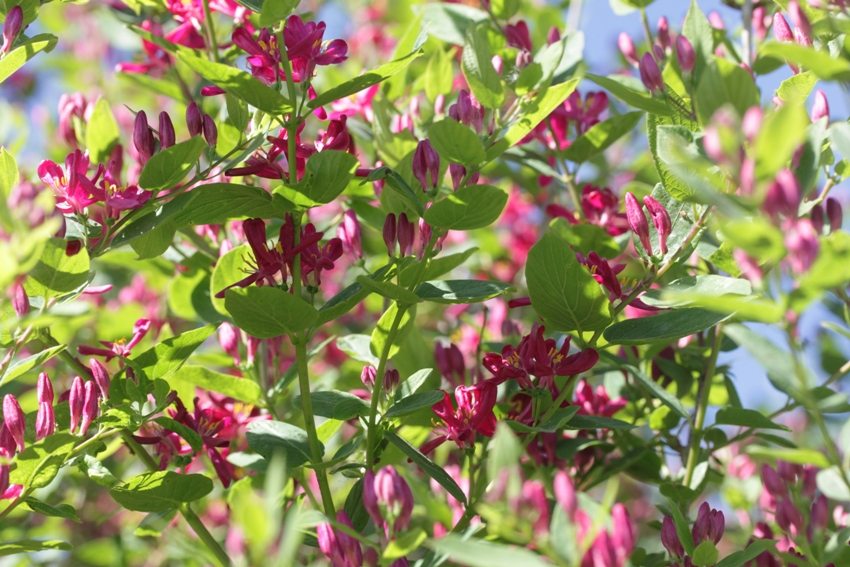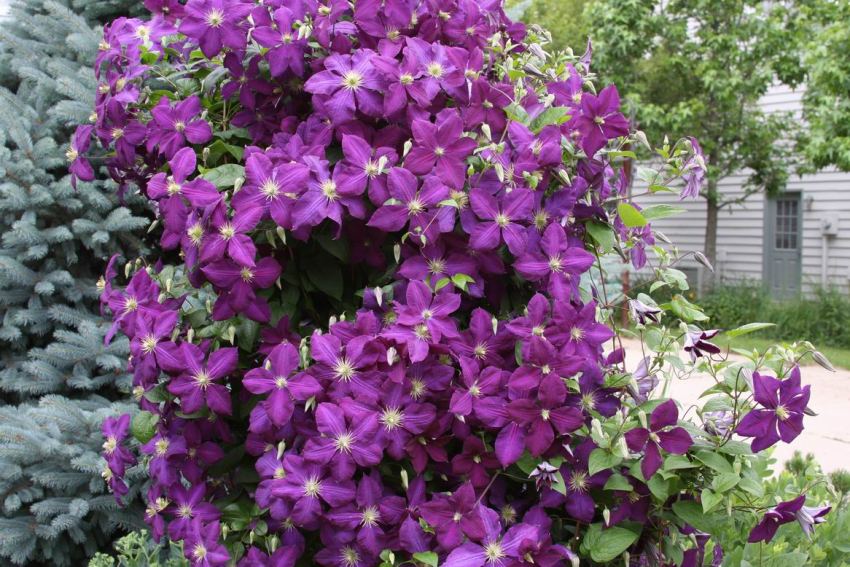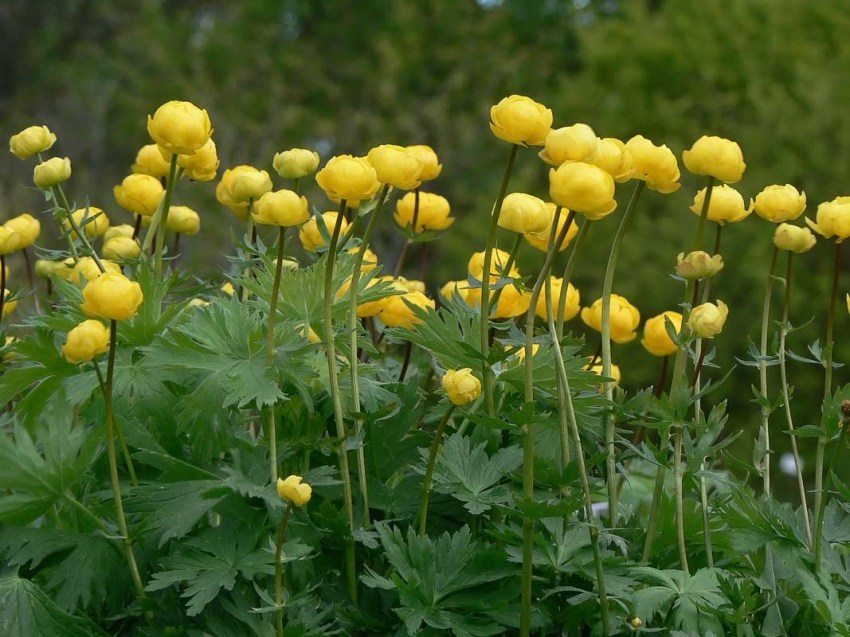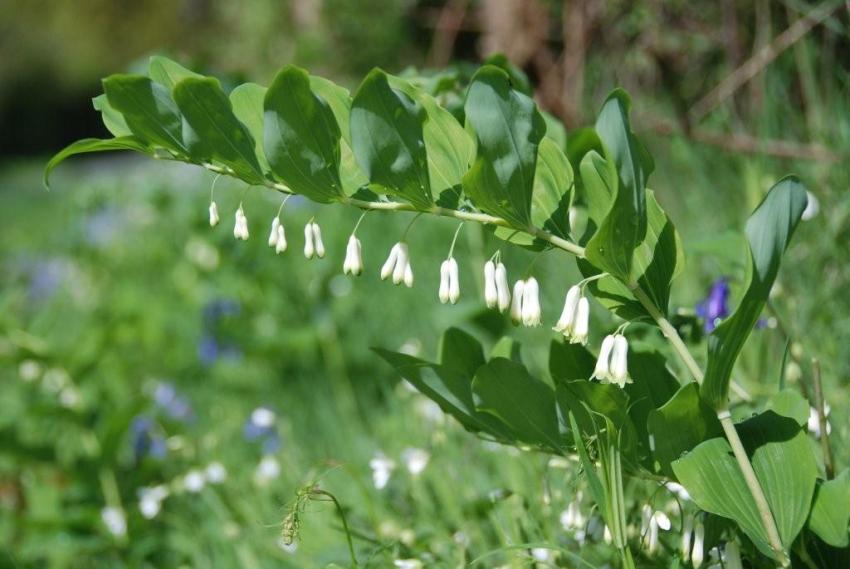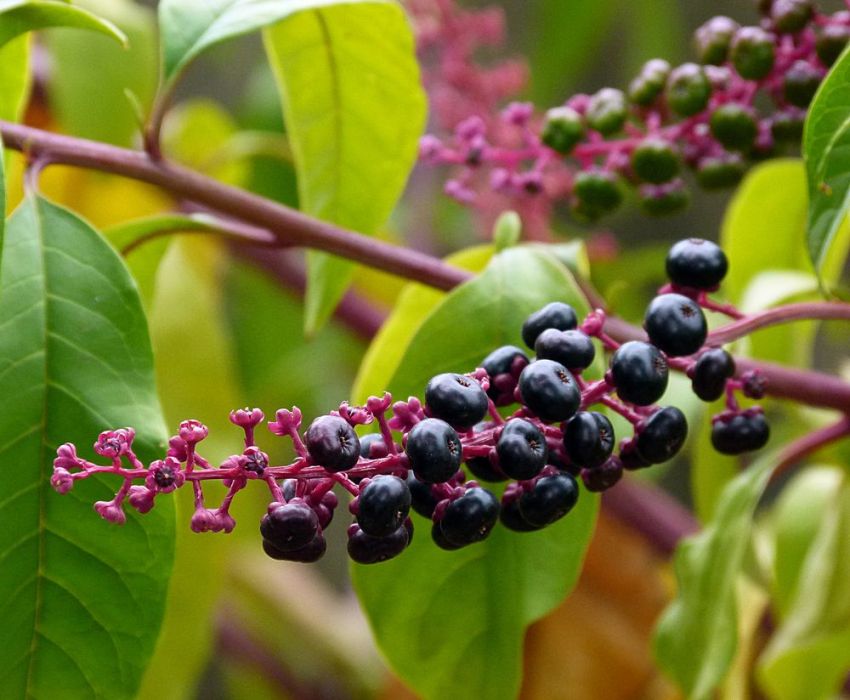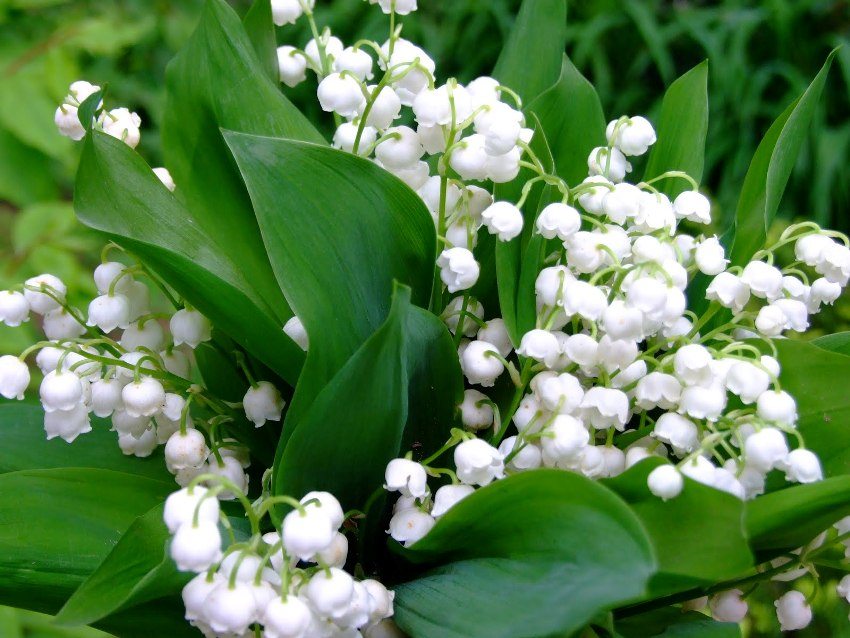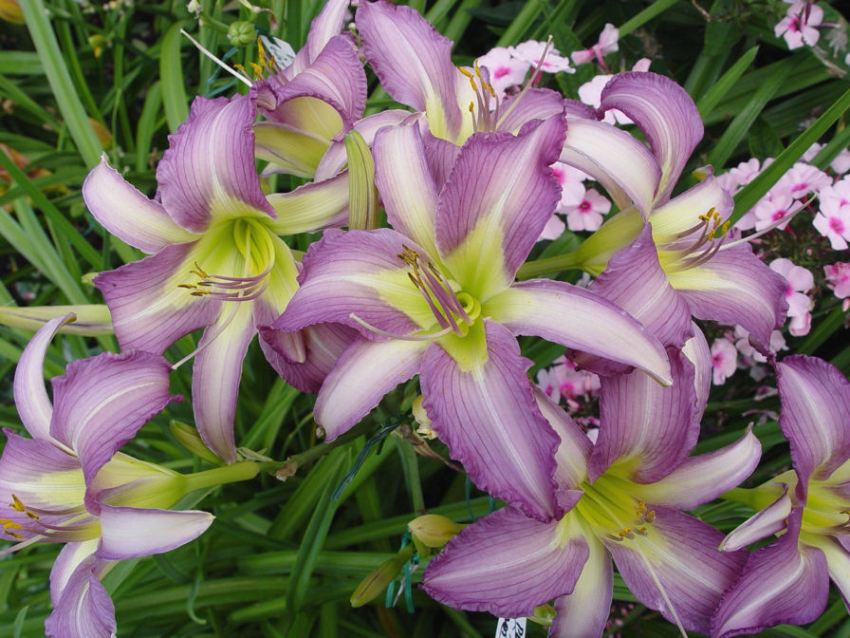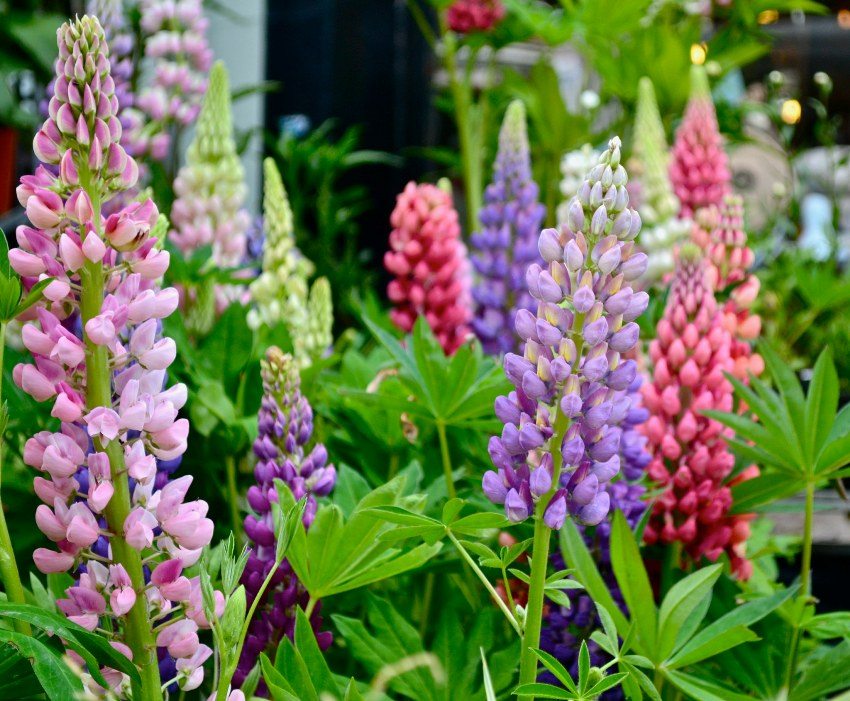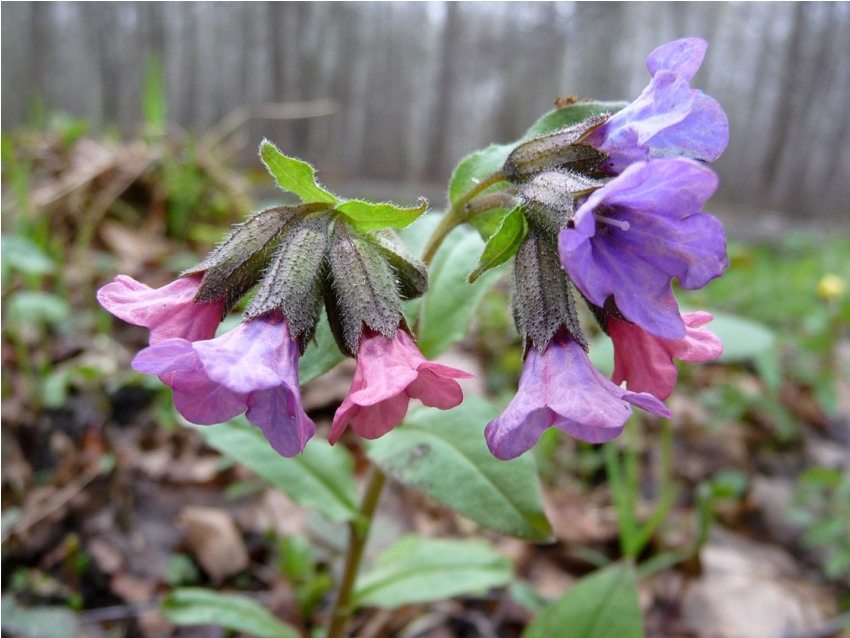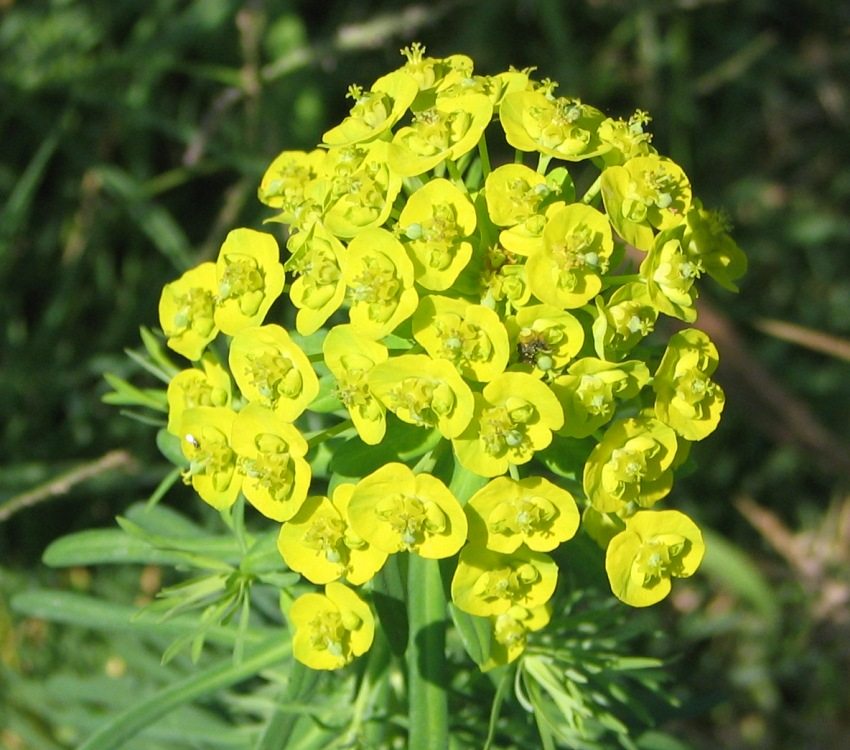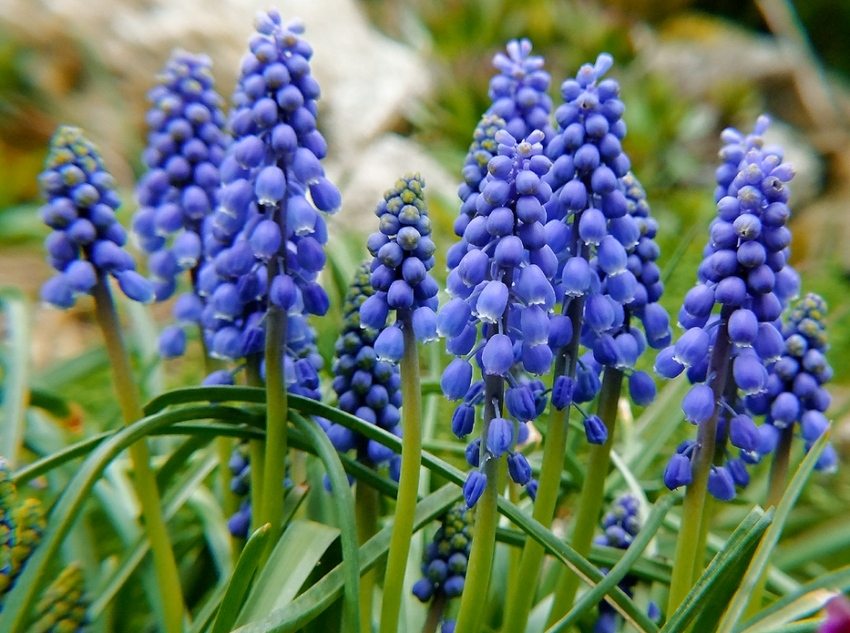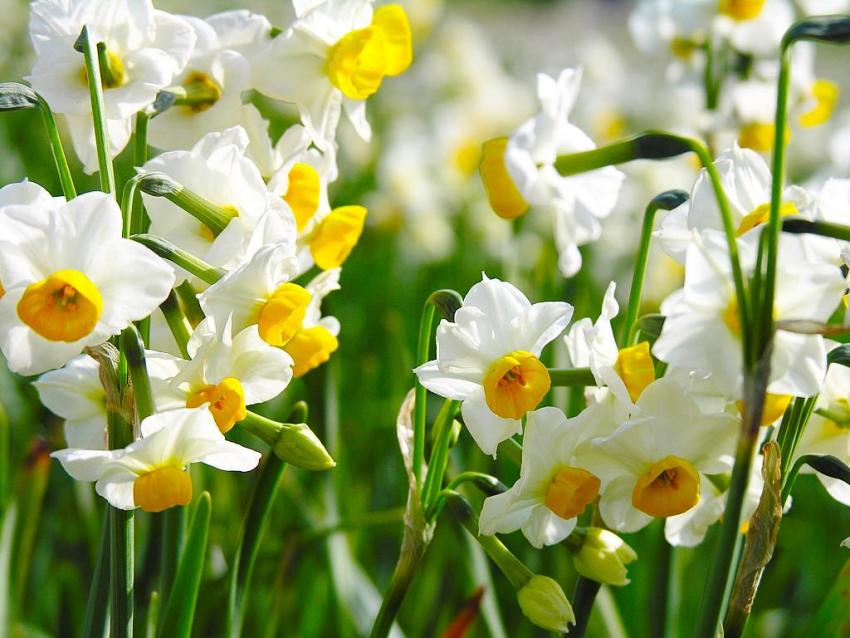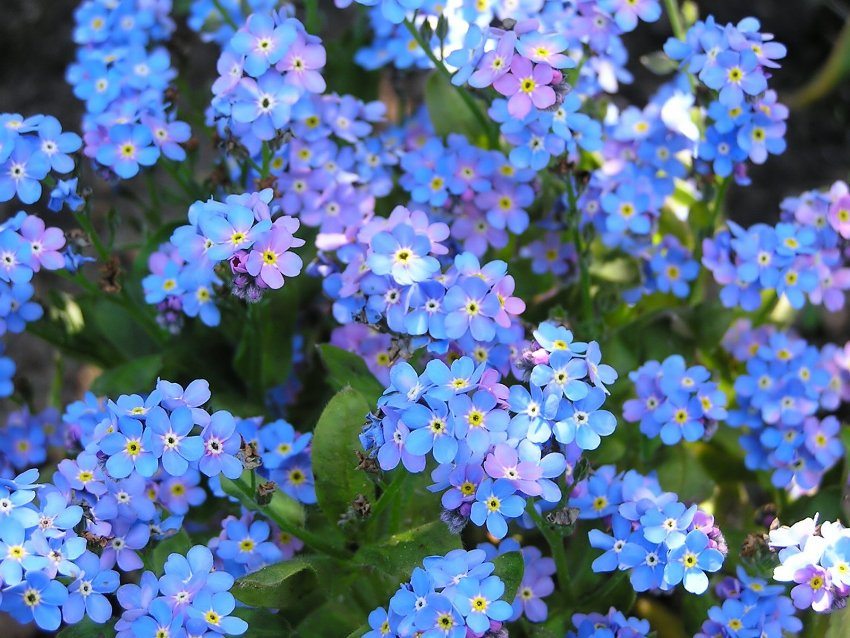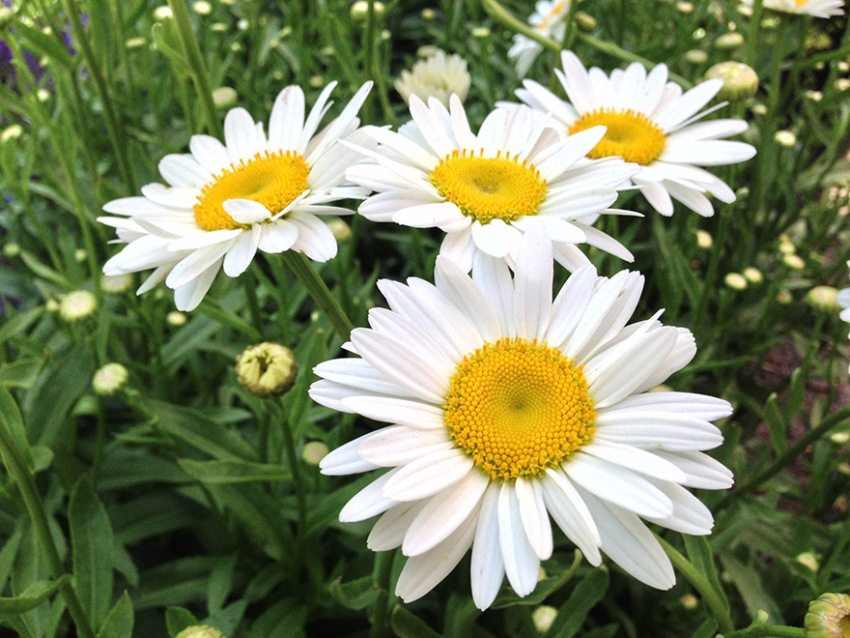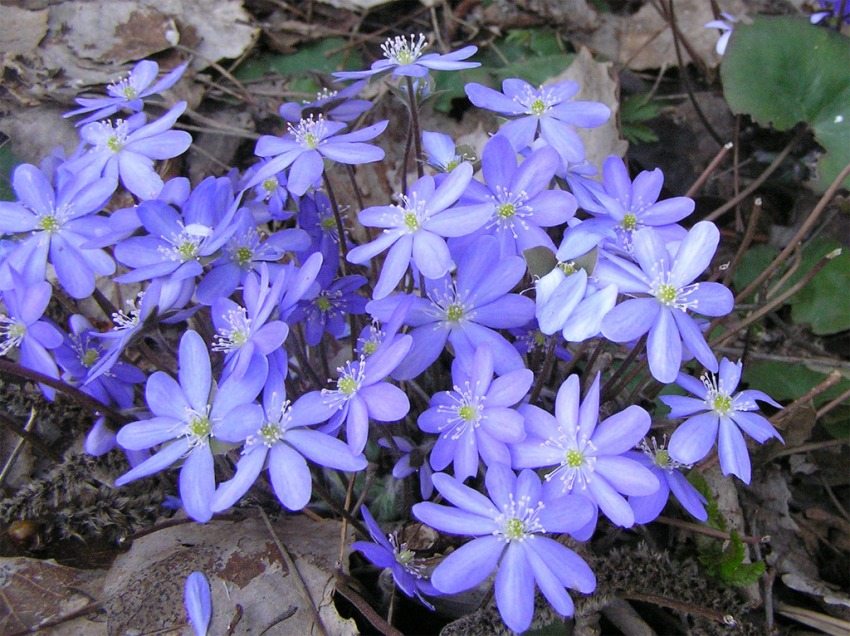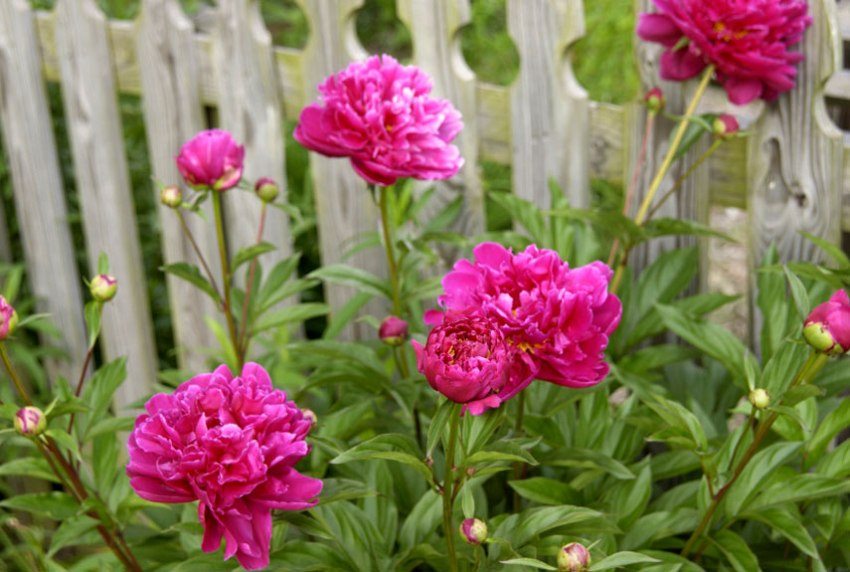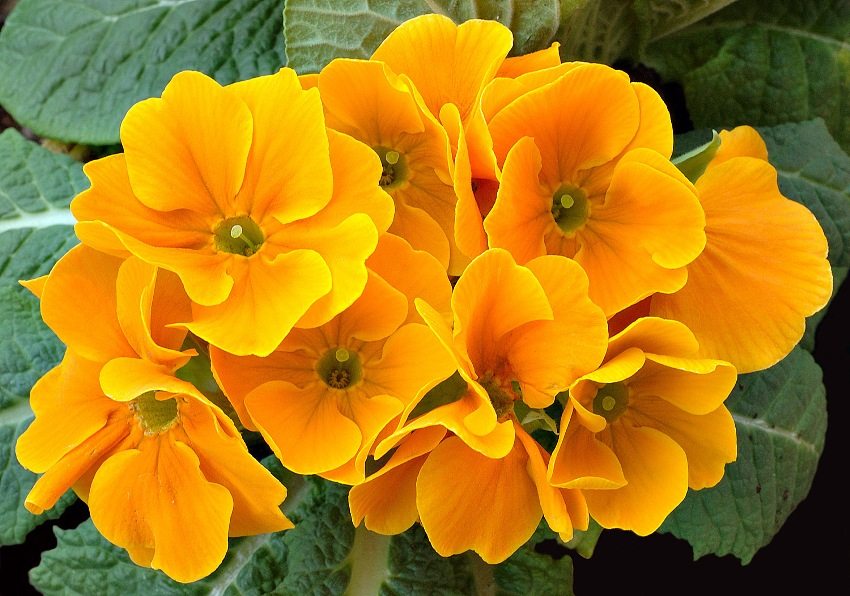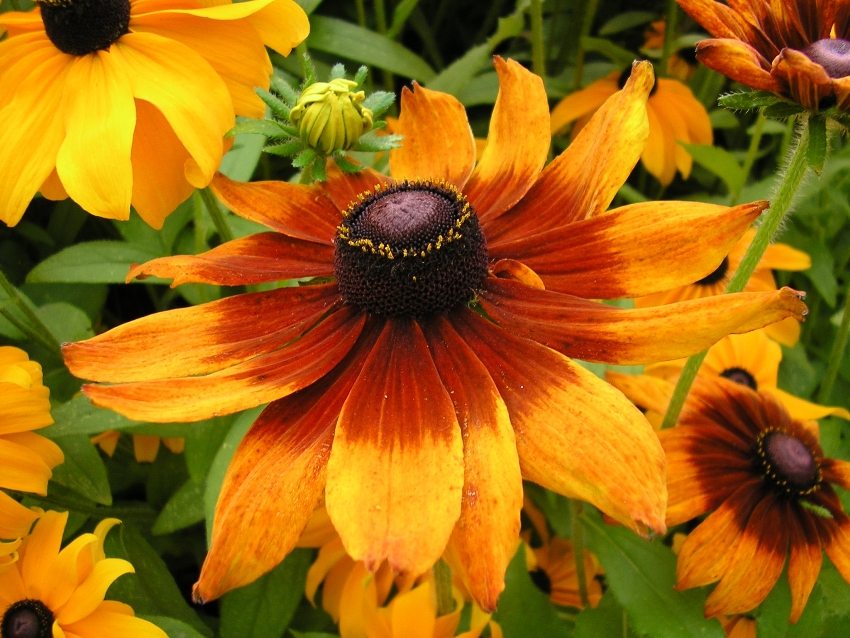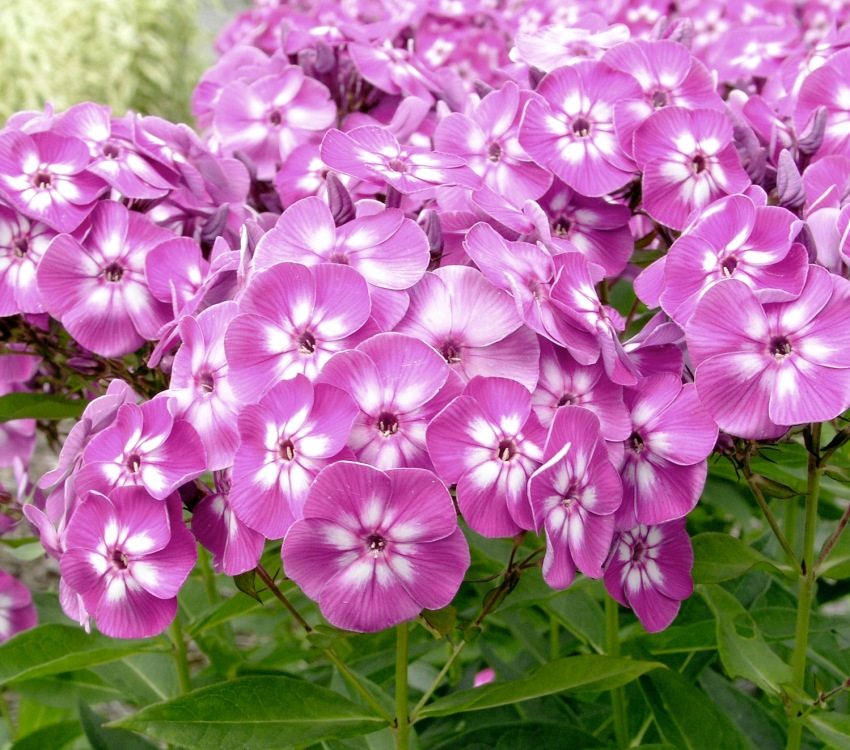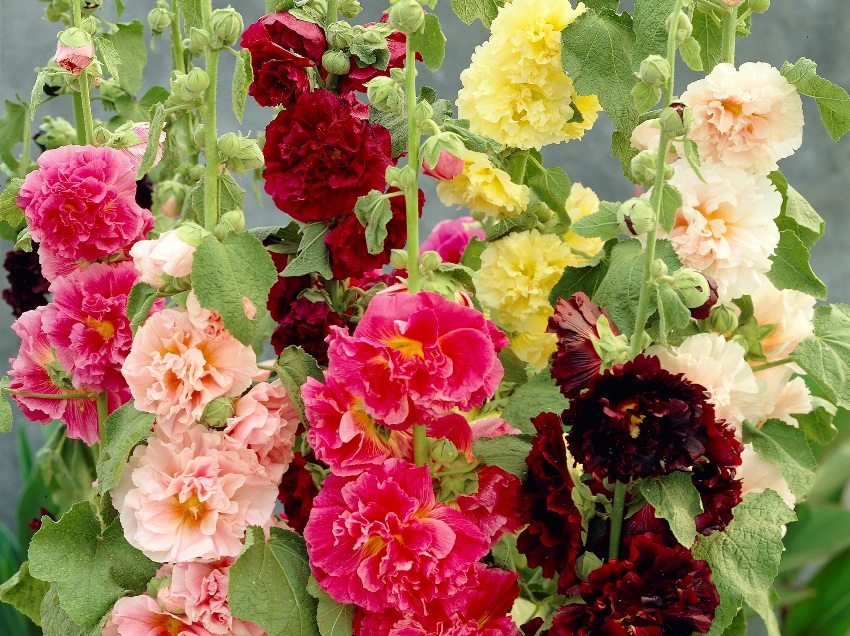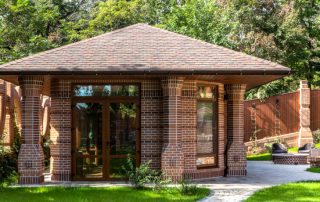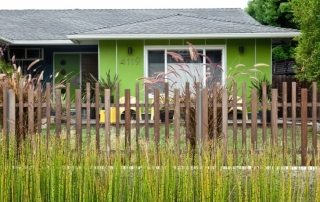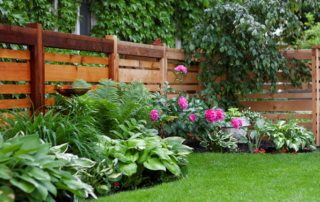A summer cottage can become not only the basis for growing fruit trees and vegetables - flowering and evergreen plants are often used to equip the territory, which are made out in beautiful flower beds and flower beds. Summer residents and gardeners can use a catalog of perennial flowers for a summer residence: photos with names will help you navigate a huge variety of plants and make the right choice for your site.
Content [Hide]
- 1 Perennial plants. Features of their use in summer cottages
- 2 Catalog of perennial flowers for a summer residence: photo with the names of the most popular plants
- 2.1 Alyssum: photo, planting and flower bed care
- 2.2 Anemones: planting and care, photo of flowers
- 2.3 Pansies: planting and care, photo
- 2.4 Astilbe: open field planting and plant care
- 2.5 Asters: planting and care in the open field
- 2.6 Badany: planting in the open field and caring for a perennial
- 2.7 Periwinkle: planting in the open field and caring for the plant
- 2.8 Colchicum: photos and plant features
- 2.9 Buzulnik: photo and specifics of this perennial
- 2.10 Verbeinik: photo, planting and care of the plant
- 2.11 Gazania: planting and care, photos of perennials
- 2.12 Hyacinths: planting in the open field and caring for perennials
- 2.13 Perennial gypsophila: planting, care, photos and plant features
- 2.14 Gladioli in the open field: planting and care, features of growth
- 2.15 Gentian: photo, planting and care in the open field, features of handling a flower
- 2.16 Delphinium: photo and flower varieties
- 2.17 Dicenter: photo, planting and care ("broken heart")
- 2.18 Tenacious creeping: photos and features of perennial care
- 2.19 Honeysuckle: photos, varieties, description of perennial and caring for it
- 2.20 Clematis: planting and care. Photo of a liana plant
- 2.21 Swimsuit: photos and landing features
- 2.22 Kupena: photo of a perennial plant on the site
- 2.23 Lakonos: photo, description of the perennial and the conditions for its cultivation
- 2.24 Lilies of the valley: photos and care recommendations
- 2.25 Daylilies: planting outdoors and caring for bushes
- 2.26 Lupins in the open field: planting and caring for flower plantations
- 2.27 Lungwitches: photo of flowers at their summer cottage and features of flower bed care
- 2.28 Euphorbia: photo of a garden flower, rules of care and cultivation
- 2.29 Muscari: photo on a personal plot and characteristics of plants
- 2.30 Narcissus: planting and grooming outdoors
- 2.31 Forget-me-nots: photo of flowers and perennial features
- 2.32 Nivyanik: photos and features of a perennial
- 2.33 Liverwort: photo and characteristics of an evergreen plant
- 2.34 Peonies in the open field: planting and caring for a flower bed
- 2.35 Pyrethrum: a photo for lovers of garden daisies
- 2.36 Climbing rose: planting and caring for the plant
- 2.37 Perennial primrose: photo, care and planting of a plant
- 2.38 Perennial rudbeckia: planting and caring for a flower bed
- 2.39 Yarrow: photo of an unpretentious and medicinal plant
- 2.40 Perennial phlox: photo, planting and care of flower beds
- 2.41 Hosta: species and photos with the name of the varieties
- 2.42 Perennial garden chrysanthemums: planting and care, photo
- 2.43 Stock rose: photo, specificity of this plant
Perennial plants. Features of their use in summer cottages
Perennials are a variety of beautifully flowering plants, including decorative deciduous species. All of them are characterized by a long growth period, in other words, these plants can form a flower bed for several years, without the need to perform a transplantation procedure or additional sowing.
Note! During this period, green spaces do not lose their decorative characteristics. Most of the perennials have no special requirements for care and growth conditions. They are characterized by early flowering, ahead of annual plant species.
Scope of application of perennials:
- hanging panels;
- volumetric compositions;
- flower sculptures for garden decoration;
- multi-tiered landscape objects.
All green spaces in this category can be used to decorate flower beds as the main background for other flowers or as a decorative addition. They differ in color, shape and height, so they can be an excellent complement to each other.
Why choose perennial plants
Gardeners prefer this type of plant to annual flowers for many very good reasons.
Related article:
Plants for an alpine slide: names and photos, do-it-yourself gardening. Types of flowers and shrubs, schemes of their placement. Recommendations for disembarkation and registration. Mixborders in landscape design.
Advantages of perennial plants:
- The ability to create a beautiful flower bed that retains its attractiveness throughout the summer season.
- The landscape design created with their help can last for several years. This period depends on the grade of the flower bed. At the same time, the gardener does not have to dig up plants every year, replant or re-sow a flower bed.
- Most of the varieties are resistant to low temperatures, so the flower bed can overwinter well in the soil without additional protective equipment. In the warm season, perennials are the first to bloom, as they have an already formed and strong root system.
- The cultivation of decorative flower beds is accompanied by minimal costs. To preserve the beauty of flower beds, you do not need to purchase planting material annually.
Helpful advice! Use perennials for additional seedlings, tubers, and seeds. Many summer residents practice a system of exchange of planting material among themselves. Use this method to get new varieties for your flower bed for free.
Catalog of perennial flowers for a summer residence: photo with the names of the most popular plants
Photos with names placed in the catalog of perennial flowers for giving can be considered as a kind of guide to the world of gardening and landscape design. Since there is a lot of seed on the market, it is worth considering the most popular varieties, which can be grown not only by professionals, but also by novice summer residents.
Alyssum: photo, planting and flower bed care
Alyssum is suitable for dry areas. It is able to withstand not only drought conditions, but also exhibits resistance to low temperatures. The plant takes root on any soil. There is no need for complex care measures.
Scope of application:
- landscape objects;
- rock gardens;
- curbs;
- compositions in need of ground cover addition.
Alyssum has fragrant flowers and rich colors. Planting is carried out on top of light soil with a high fertility rate. The plant needs sun and is combined with elements such as paved slabs fences, paths, rocky crevices. Alyssum requires moderate watering and increased nutrition at the first stage of development.
Anemones: planting and care, photo of flowers
This type of plant belongs to the genus Anemone. Photos of anemone flowers show purple, blue and bright red hues. In harsh areas, the plant is grown as an annual. The diameter of the flowers is 70-80 mm.
Helpful advice! To decorate bouquets, it is recommended to cut off the buds of anemones that have not yet fully blossomed and have a weak color. The vase should be filled with water a quarter of the length of the peduncle, and the petals should not be wetted.
Planting and caring for anemones is fairly simple. The tubers are planted in moderately fertile soil in a sunny location to a depth of 5 cm. The soil must be breathable. In a poorly fertile soil, the plant will need feeding. It is better if it is a complex-purpose mineral fertilizer, which should be introduced into the soil twice a summer.
Pansies: planting and care, photo
Pansies are among the most popular plants. Their second name is viola. Perennial is characterized by a huge number of colors:
- snow-white;
- yellow;
- blue;
- with red spots;
- black.
A sunny place and moist loam with a high level of fertility are optimal conditions for planting, they will increase the flowering period. Planting in lowlands where liquid stagnates is best avoided. The plant requires frequent feeding; superphosphate and ammonium nitrate are suitable for these purposes. The use of fresh manure should be discarded.
In order to extend the flowering period, areas that have faded and seed boxes are removed. Otherwise, seed ripening will take a lot of energy from the plant.
Astilbe: open field planting and plant care
Many owners of suburban areas are attracted by beautiful photos of astilbe. Planting and caring for this plant may vary, as the perennial has several varieties, which can be dwarf, short, medium or tall.
The plant is crowned with inflorescences in the form of panicles of various colors. In matters of planting and leaving, Astilba has the following requirements:
- penumbra;
- humus-rich soil;
- watering on a regular basis (afraid of overheating of the roots);
- removal of peduncles after the end of the flowering period.
Helpful advice! The bare root system should be covered with a special covering material or spruce branches should be used to protect the plant so that the plant does not die from frost.
Asters: planting and care in the open field
In the photo, aster flowers look spectacular, and this is not surprising. This perennial is considered the dominant plant of all that can only be in the autumn garden. Aster is characterized by abundant flowering until the beginning of the first frost.
The palette of shades is diverse: dark purple, white, delicate lilac, light violet, deep pink.
Nursing and Fitting Requirements:
- location area - weak partial shade or sunny area;
- light soils with good water permeability;
- fertilizers of organic and mineral origin;
- abundant watering;
- separation of bushes and planting every five years.
The scope of application extends to the design of the edges of flower beds and paths. Plants can play the role of curbs and carpet flower beds.
Badany: planting in the open field and caring for a perennial
Badan leaves with a shiny surface are rounded, and its flowers are pink. The plant is characterized by good development in fertile soils. It is recommended to place incense in areas with slight shading. Lack of sunlight can delay the flowering period and affect beauty. Poor soils can also be the basis for plant growth. Thanks to regular feeding, the perennial is able to form rosettes.
Scope of application:
- flower beds of group type;
- rocky areas of the garden;
- discounts and borders.
Note! A plant that has survived the winter is very vulnerable to fungal attack. Therefore, since spring, it is recommended to feed berry and treat its deciduous part with protective preparations.
Periwinkle: planting in the open field and caring for the plant
Periwinkle belongs to the climbing and creeping plant species of the ground cover type. It has the ability to grow rapidly in breadth. The leaves of this perennial have a leathery structure covered with gloss. In most cases, they are dark or light green. In rare cases, the leaves are covered with spots of gold or cream shades.
The plant quickly forms a root system, prefers partial shade conditions. In this case, the soil can be almost any. The only condition for normal development is the absence of drying out. Watering should be done on a regular basis. It is recommended to cut the plants. In severe winters, protection in the form of a covering material is required. A good neighborhood will be: woods, primroses, hyacinths and heucheras.
Colchicum: photos and plant features
Colchicum bears some resemblance to crocuses. The second name of the plant is colchicum. It is very easy to distinguish a perennial from a crocus. Just look at the flowers, which in this case are much larger and have a very pleasant aroma. One bulb can form up to four beautiful flowers at a time.
The flowering period is about three weeks. The pollinated flowers wither immediately, but subsequently they tolerate wintering well under the snow. In terms of soil and care, the plant is unpretentious. The same goes for growing conditions, which may be accompanied by abundant solar currents or shade.
It is recommended to plant croplands on alpine slides. Beds with continuous flowering are also suitable, even ordinary flower beds.
Buzulnik: photo and specifics of this perennial
The large leaves of the buzulnik and its unusual color attract summer residents. A perennial is valued for its abundant flowering over a long period and absolute unpretentiousness. The optimal conditions for the development of a plant can be created with equal success by both a shade and a sunny area.
Helpful advice! The sun area should be chosen carefully, as an excessive amount of light leads to burnout and damage to the leaves.
Planting in soils with sufficient nutrient and moisture levels is recommended. Watering is carried out as needed. The period of application of fertilizers of organic and mineral origin falls on the spring and early summer. In autumn, peat mulching and cutting of perennials almost to the root zone are performed. There is no need for shelter for the winter.
Verbeinik: photo, planting and care of the plant
Summer residents call loosestrife lysimachia. This perennial can be in the form of an erect plant or creeping shoots. Colorful photos of loosestrife vividly reflect how impressive it can look flower bed on a garden plot with these yellow or red flowers. Some of them can be used for medicinal purposes.
Most of the plants of this species prefer abundant sunshine, only some varieties feel better in a shaded place.
Care Requirements:
- wet soil;
- abundant watering on a regular basis;
- fertilizing with complex mineral fertilizers twice a month.
The plant tolerates cold well and does not need to use a covering material.
Gazania: planting and care, photos of perennials
Gazania (or gatsania) refers to plants that bloom in the summer with an extensive palette of colors. For this reason, landscape designers have named it the South African chamomile.
Note! The genus of perennials gazania unites almost 40 varieties growing in warm countries. Some of them can develop in cold regions, but already in the form of annuals.
Due to its unpretentiousness, gatsania can be grown:
- in flowerpots;
- in rock gardens;
- in boxes on the balcony;
- as a border decoration.
It requires a lot of sun and open area for normal development. The constituents of the soil should be turf mixed with sand. Stagnant water is highly undesirable. Even in dry weather, a perennial needs moderate watering.
Hyacinths: planting in the open field and caring for perennials
Planting hyacinths and caring for them primarily comes down to the use of fertilizers. To obtain large and full flowers, dry type dressing is used, which is introduced into the soil immediately after the first shoots appear, and the first loosening of the earth is done.
The second fertilization is done during the period when the buds were formed. This time, the fertilizer is applied to the root in liquid form. For the third time, feeding is carried out after the hyacinths have bloomed. This type of plant is characterized by special watering requirements. Do not allow the soil to dry out before the bulbs take root. The ground must remain moist. During the remaining period, when the shoots are already visible, watering should be carried out on a regular basis, especially in dry weather.
Perennial gypsophila: planting, care, photos and plant features
Gypsophila has the appearance of a flowering shrub. Its delicate white or pink flowers cover the perennial abundantly, creating the effect of an airy haze. Photos of gypsophila, which can be found on the network, clearly show that this type of plant will look beneficial:
- in the background of the garden;
- at the walls of the retaining purpose;
- in the rock garden.
Perennial is characterized by increased resistance to winter cold. The main preferences are light soil with a high level of fertility and moisture, sunny area.
Helpful advice! Gypsophila is extremely vulnerable to transplantation. To increase the percentage of successful outcome, you should pre-treat the root system with a root stimulator.
Gladioli in the open field: planting and care, features of growth
The exquisite gladiolus is planted in an open area. In this case, wind protection must be present. It is not recommended to place perennials in areas where water can accumulate and stagnate.
In areas characterized by increased dryness and heat, gladiolus will need light shade. The midday sun can be detrimental, so flowers will need protection from high temperatures and direct sunlight.In areas with moderate climatic conditions, even a light shade can cause a drop in the level of decorativeness and delay in flowering.
Gladiolus reacts well to sandy loam soil, which must first be processed 20-30 cm deep and saturated with organic fertilizer.
Gentian: photo, planting and care in the open field, features of handling a flower
The gentian is a perennial plant that blooms with blue bells. The active flowering period coincides with the summer season. This mountain flower is recommended to be planted on alpine hills. The group of perennials of this genus includes more than four hundred varieties and varieties.
Like all low-growing plants, the gentian needs a careful approach with regard to fertilization. A fertilizer high in nitrogen can harm the plant. The sun's rays should be dosed, but this does not mean that the flower should be placed in the shade. Dried shoots must be removed from the flower bed.
Delphinium: photo and flower varieties
The seeds are laid in the soil in March. Landscaping designers advise making a dense planting to keep the flower bed lush. After that, the flower bed is sprinkled with a layer of soil about 0.3-0.4 cm thick.
The category of perennials includes the following varieties of delphinium:
- Persian;
- large-flowered;
- holosteel;
- hybrid.
The flower loves regular watering, especially in dry weather conditions. The damp earth is then loosened, but very carefully.
Useful advice! Delphinium loves root watering. The correct irrigation system will eliminate the appearance of powdery mildew (disease).
Dicenter: photo, planting and care ("broken heart")
In the photo of a perennial dicenter, you can see arcuate inflorescences dotted with heart-shaped flowers, which can be white, pink or light purple. In total, this genus has about ten cultivated plant varieties.
The most important condition for the successful cultivation of a dicenter is a correctly selected planting zone. In partial shade, she feels best, but a sunny area will also be an excellent place for a flower to live, provided that it is watered on time. The soil should be rich in mineral and organic composition. You can fertilize it with humus before planting.
Tenacious creeping: photos and features of perennial care
Gardeners love tenaciousness for its resistance to the negative effects of weather conditions. She does not show vulnerability to pests and diseases. Due to the dense flowering, even in conditions of minimal sunlight, the tenacious can be planted in specific areas of the summer cottage.
Scope of its application:
- decoration of rocky slopes;
- landing at the bottom of the green hedge;
- decoration of tree trunks in a circle.
The procedure for seating, disembarking and replanting can be carried out throughout the summer season. For plants, loose types of soil with an admixture of peat, sand or sod are good.
Honeysuckle: photos, varieties, description of perennial and caring for it
Honeysuckle is a shrub that bears fruit. There are a lot of varieties of this plant, but if you limit yourself only to those where edible berries grow, the choice will be between honeysuckle:
- edible;
- Altai;
- Kamchatka;
- Turchaninov.
The shrub is unpretentious to care for and can take root anywhere on the site where you want to plant it. The main thing is to have protection from the wind and enough sun.
Useful advice! Honeysuckle does not like loneliness, as well as neighborhoods with specimens of the same grade. In both the first and second cases, the yield of perennials falls significantly.
Clematis: planting and care. Photo of a liana plant
Clematis can be a worthy decoration for any garden, suburban area or courtyard in a private house.
Perennial benefits:
- resistance to winter conditions;
- long flowering period;
- unpretentious care;
- durability.
Clematis is thermophilic and prefers the sun. Disembarkation is carried out in increments of 2 m. Low-lying areas or areas adjacent to groundwater are considered bad places. The soil must be selected loamy or sandy. In heavy soil, the installation of a drainage system is imperative. In winter, perennials need protection.
Swimsuit: photos and landing features
To plant a swimsuit, preliminary soil preparation will be required. For good development of perennials, shade should be provided. In sunlit areas, the plant can also grow, but the abundance of light will cause the flowers to shrink and fade quickly.
Soil requirements:
- looseness;
- humidity;
- the presence of drainage.
It is better to refuse to plant a swimsuit on sandy or dry ground. The flower needs regular watering, weeding from weeds, and loosening of the earth. Top dressing is also important. The best nutrition for the plant will be the dosed administration of nitrofroska, Agricola and urea in combination: a tablespoon of each fertilizer and 10 liters of water.
Kupena: photo of a perennial plant on the site
Kupena is considered one of the little-known garden perennials. The plant has a family relationship with Liliaceae. On its curved stem, greenish-gray leaves and small bell flowers with a green border hanging in droplets are adjacent.
Areas with little or significant shade are the main habitat of the humble but attractive plant. The sun's rays slow down its growth and negatively affect the decorative characteristics of the purchase.
Note! This perennial has medicinal properties: it strengthens the immune system, speeds up metabolism.
Lakonos: photo, description of the perennial and the conditions for its cultivation
Lakonos is a large perennial plant. America is considered his homeland. During the period of summer growth, the lakonos from small seeds turns into a lush bushy plant. Height can reach 1 m. By autumn, the peduncles are covered with black berries with a characteristic shine.
Both the juice of the plant and its berries are very poisonous. But this does not prevent gardeners from placing the lakonos in the very center of their compositions. In the middle of a flower garden, a perennial is unlikely to be a danger. It can become a background add-on fence, because open sunny areas are contraindicated for him.
Lilies of the valley: photos and care recommendations
A favorite place for lilies of the valley is moist soil hidden under the dense shade of trees. Perennial perfectly tolerates prolonged absence of sunlight. But if the shadow is deep, the number of flowers will decrease. Instead, the lily of the valley will grow the deciduous part. Exposure to wind will also not be beneficial, reducing the number of flowers.
Useful advice! Gardeners recommend planting lilies of the valley along walls and fences.
Hot weather conditions are detrimental to perennials. Don't forget about watering your plants. It is better to completely abandon transplants. Low fence around flower beds will avoid strong overgrowth.
Daylilies: planting outdoors and caring for bushes
Shrubs sit in the planting pit. For a daylily, the depth of such a pit is about 20-25 cm, and the perennials themselves are placed in increments of 0.4-0.6 m.Before placing the bush in the recess, you should pour some fertile soil on the bottom. And this must be done in a slide. The roots will subsequently be straightened along it.
The zone where the transition from the root system to the leaves takes place is called the "neck". It sinks into the ground by about 2-4 cm. The daylily requires abundant watering and mulching of the soil. It is recommended to cover the ground near the plant in a circle of 4 to 7 cm. After planting, the plant will need to be watered and fertilized regularly.
Lupins in the open field: planting and caring for flower plantations
The decorative characteristics of this flower are very high. It is for the natural beauty that gardeners love lupines so much, planting and caring for which is a pleasure. The plant's exactingness to the soil is not high, but, as with other perennials, the rule applies here: the more fertile the land, the more magnificent and beautiful the plants bloom.
If you want to achieve optimal conditions for growing lupins, you should give preference to acidic types of soil. In such an environment, the plant improves the composition of the soil by independently forming a nitrogen-containing fertilizer on its tubers. To increase acidity, it is recommended to add sawdust and manure to the soil composition.
Lungwitches: photo of flowers at their summer cottage and features of flower bed care
The lungwort, called pulmonaria among landscape designers, is distinguished by the beauty of flowers with a very early flowering period. Despite this, today it can not be found in every garden.
With the help of this flower, you can make a wonderful design of the site:
- live curbs;
- ridges along garden paths;
- ground cover addition to flower gardens.
Plant the lungwort in a cool and shaded place, and this plant can delight the eye with flowers, even in poor soil. Sandy composition is preferable. A perennial needs moisture and regular watering; mulching needs to be done for the winter.
Euphorbia: photo of a garden flower, rules of care and cultivation
To plant milkweed in your garden, you need to take a sunny place. In extreme cases, the cultivation of a perennial in partial shade is allowed, but the flowering of the plant will not be so abundant.
Important! Heavy soils are a very poor basis for planting milkweed. Growth slows down, and in winter the root system will rot.
Watering should be moderate. For the period of vegetative development, no more than two dressings are allowed with the help of fertilizers of mineral origin. The timely removal of dead inflorescences and pruning will help to preserve the external attractiveness of the green planting.
Muscari: photo on a personal plot and characteristics of plants
This type of perennial belongs to the Hyacinth family. Even the muscari depicted in the photo is able to create a joyful and spring mood. For a flower bed in a summer cottage, it is difficult to find a more interesting specimen.
The bulbous plant is completely unpretentious. Muscari have earned their name due to their specific scent, which has similar notes to musk. Muscari is used by gardeners:
- Turgenevsky (light blue);
- Armenian (blue with white border);
- racemose (purple);
- aciniform (white, blue, blue-violet).
Muscari love abundant watering and sun. They normally perceive partial shade. Some varieties reproduce by self-sowing.
Narcissus: planting and grooming outdoors
Daffodils in the company of tulips can be a beautiful addition to a personal plot. They bloom very early and are presented in a wide variety of varieties:
- onkel-like;
- tubular;
- small-crowned;
- terry;
- cyclamen;
- large-crowned;
- taceniform;
- poetic.
Planting plants is straightforward, the main thing is to guess the timing. The package usually lists the ideal month for planting daffodils. Required care conditions: regular loosening of the soil, watering (especially after flowering), removing diseased plants and jigging daffodils of a different variety.
Forget-me-nots: photo of flowers and perennial features
If you want to see what a bruner looks like, take a look at the forget-me-not flowers (the photo also vividly conveys the appearance of this pretty spring plant) The perennial blooms in late spring with light blue small flowers. After flowering, they are replaced by heart-shaped pointed leaves. These leaves have a sharp tip. Practically no special care is required.
Important! The plant needs moisture. With a lack of watering, the leaves will wilt. Therefore, the timing of watering should be carefully observed, and it is better to plant the perennial itself in clay soil, which constantly retains its moisture.
Nivyanik: photos and features of a perennial
Nivyanik has many names: white chamomile, Roman grass, popovnik, white flowers. This flower is a frequent inhabitant of gardens and suburban areas. Perennial is characterized by high resistance to negative weather manifestations (frost) and unpretentiousness. Timely removal of baskets that have already faded will extend the flowering time of this amazing meadow plant.
Given the origin of the daisy, it becomes clear that the perennial prefers an open and sun-drenched area. Areas where water stagnates are best avoided. A properly grown chamomile can do without transplanting for 5, and sometimes 7 years.
Liverwort: photo and characteristics of an evergreen plant
The herbaceous plant liverwort has another name - copse. The perennial belongs to the extensive Buttercup family. Its habitat is considered to be forests in northern latitudes with moderate climatic conditions. In the gardens, you can meet only one species - the noble liverwort. Globally, there are thousands of varieties of this plant.
The liverwort has a long lifespan. Under conditions of cultivation and appropriate care, the plant can live up to 25 years. In nature, this indicator does not occur due to the fact that the liverwort needs moist and very fertile soils.
Peonies in the open field: planting and caring for a flower bed
Peonies can often be found in parks and gardens. This light-loving perennial loves fertile soil. In optimal conditions in one place, he is able to live up to 50 years.
For planting, you should select sunny, but protected from the wind, areas of the territory. Peony bushes are prone to overgrowth, therefore, when decorating the paths, a certain distance should be left between the path and the planting pits. It is not recommended to plant a perennial under the walls of a building. Rainwater from the roof will increase soil moisture, and when the water stagnates, the root system of plants will rot.
Pyrethrum: a photo for lovers of garden daisies
If you see a colored chamomile in front of you, then the photo shows feverfew. Planting and caring for these plants is specific, but simple enough. An unpretentious perennial grows well both in sunny flower beds and in shaded areas.
Note! In the absence of direct sunlight, the shoots of this plant can stretch out.
There are no special requirements for soil, but high moisture and poor soil composition can slow down the development of pyrethrum. Watering schedule should be regular, but in moderation.If you remove in time the peduncles that have already outlived theirs, the perennial will be able to bloom again.
Climbing rose: planting and caring for the plant
Climbing roses are suitable for creating a romantic atmosphere in almost any area. This perennial cannot do without sunlight, so it is better to organize planting in an open area with a good level of ventilation. Swampy and lowland areas are not suitable for growing roses.
It is not recommended to break the bushes in the place where the flower bed was previously, otherwise the plant will not take root. In order to avoid the death of roses, it is recommended to plant them on slopes or hills. This will relieve the soil in the growth zone of bushes from waterlogging, which often occurs during rainy periods or in areas with groundwater lying near the surface.
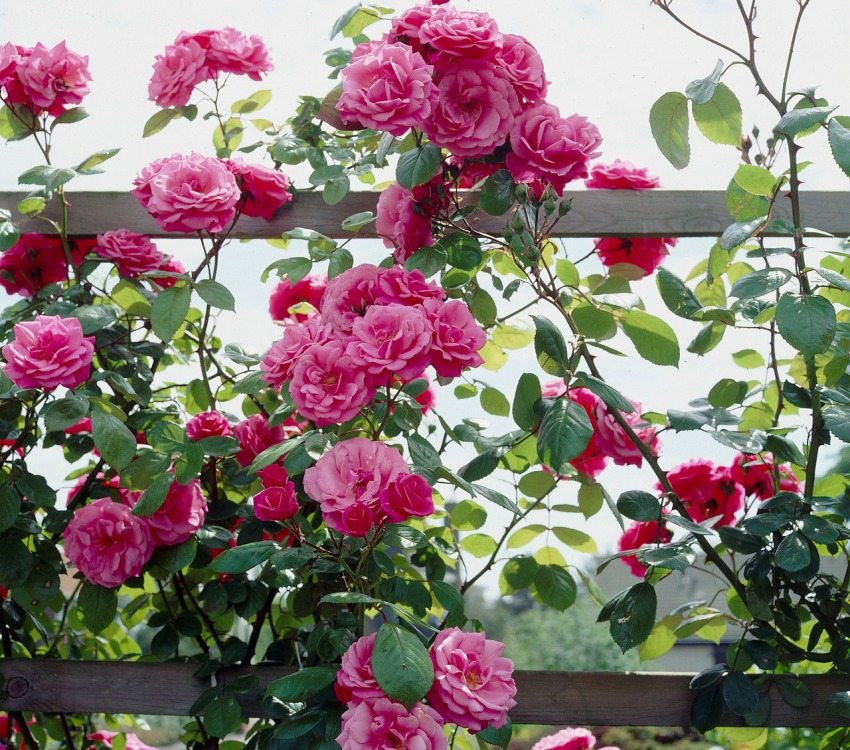
A climbing rose is planted near fences pergola or arches
Perennial primrose: photo, care and planting of a plant
Primula is called primrose because of its early flowering. It is for this that she is a favorite perennial of summer residents and gardeners. In the photo of the perennial primrose, there are purple, yellow, red and blue flowers.
Note! This type of plant is widely used in folk medicine.
Before planting, it is worth introducing fertilizers into the soil. The earth must be moist. Garden outskirts with good shade are best suited for these purposes. The plant takes root well under pears and apple trees. Cool conditions are considered optimal. Humus from last year's foliage can be used as food.
Perennial rudbeckia: planting and caring for a flower bed
The variety of rudbeckia is varied. The plant has similarities to chamomile. Their petals bent to the bottom can have different colors:
- yellow;
- blue;
- lemon;
- brown;
- orange.
The plant is not demanding in terms of land. Feels better on well-groomed soils fertilized with humus and with high water permeability. The period of growth of a perennial in one place without transplanting is 5 years.
During the growing season, fertilizing in the form of potassium sulfate and nitrophoska is recommended. Dead flowers should be removed, as well as young growth (as needed, if the bushes are heavily overgrown).
Yarrow: photo of an unpretentious and medicinal plant
Yarrow is very popular among owners of suburban areas involved in flower bed decoration. Its inflorescences have a bright color (red, white, pink, orange, cherry, yellow), retain their attractiveness for a long time, and the plant itself is considered medicinal.
There are almost two hundred varieties of this perennial. Its natural habitats are mountain meadows, rocky and rocky terrain, glades, which ensured the high resistance of the plant.
Note! Yarrow is not only able to withstand sudden temperature changes, it can tolerate periods of prolonged drought normally.
Perennial phlox: photo, planting and care of flower beds
Thanks to the work of breeders, the variety of phlox has increased, and these unusually beautiful plants have become obligatory inhabitants of decorative flower beds in suburban areas. Even a little care makes phlox flourish in lush colors.
The plant is able to take root even on heavy soils. To do this, you just need to add sand with coarse grains to the bottom of the planting pit. In sandy soils, a layer of clay will not interfere. Phlox is planted 2-3 cm deep into the ground (the root collar is buried at this depth). For good flower development, you will need an open area with sun and protection from the winds.
Hosta: species and photos with the name of the varieties
The plant loves the shady coolness of the gardens and does not need careful care, as evidenced by the beautiful photos of the host in the landscape design of suburban areas. The decorative perennial has many varieties:
- Christmas Eve;
- White Christmas;
- Alex Summers;
- Mango Tango;
- First love, etc.
You can easily get confused about the variety of plants, since many of them are based on sports (shoots that differ significantly from the maternal perennial).
Note! Sandy soils slow down plant growth. Moreover, the composition of such soil enhances the color of the leaves. The recommended soil condition is shade and moisture.
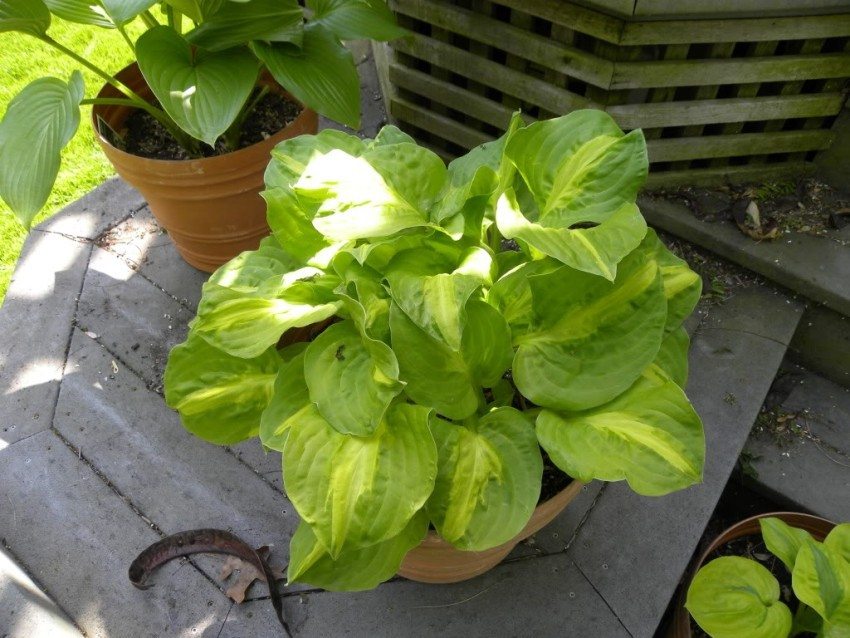
Hosta variety "Tango Mango", planted in flower pot
Perennial garden chrysanthemums: planting and care, photo
Chrysanthemum has a 3 thousand year history. It was first domesticated for garden purposes in China. The plant is characterized by lush flowering. To achieve this result, it is necessary to choose the right time and place for planting.
When the perennial is in the ground, the first pinch is done. In other words, growth points are removed. This procedure is repeated three weeks later and the upper part of the shoots is removed. Chrysanthemum reacts poorly to lack of moisture and does not like thick shade.
The best landing site is a hill. Soil requirements: looseness, moisture permeability, fertility. Peat, compost, rotted manure will not hurt.
Stock rose: photo, specificity of this plant
The stem rose is distinguished by beautiful flowering and photophilousness. Therefore, it should be placed in an area that is well lit by the sun. The shade will not only delay the growth and development of the perennial, but it can also cause the lack of flowers. Moreover, the plant can be in this state for two years. Poor and dry soils are also not desirable.
The irrigation scheme should be moderate, because a large amount of liquid can provoke rotting processes in the roots. The soil should be fed with nitrogenous fertilizers. Dead flowers cause depletion of the stem-rose, so you need to get rid of them.
Having studied the characteristics and features of each of the plants presented in the catalog, you can learn how to form unique flower arrangements. Many perennials have similar planting, feeding, and watering requirements. Based on this information, you can create accurate layouts for beautiful and colorful flower beds.
